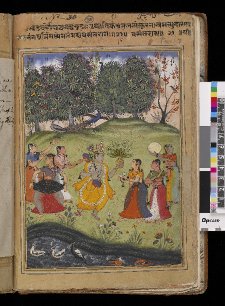On the eve of the Indian spring festival of Vasanta Panchami, today’s picture comes from the British Museum’s “Manley Ragamala”: an album of paintings named after its last English owner but originally created in about 1610 by an anonymous artist attached to one of the courts of Rajput in Rajasthan. The literal meaning of Ragamala is “garland of melodies”, in reference to the fact that each image in albums of this kind was designed to relate to a specific sort of music, as well as to a distinct emotion and a particular time of year. The image reproduced here is the Vasanta Ragini, or “Vasanta festival melody”. It is not difficult to imagine the mood and the music which this highly animated depiction of Krishna dancing with the cowgirls of his legend was intended to conjure up: something life-affirming and even fairly riotous, to judge by the various instruments shown, which include the cowgirls’ own accompanying drums, cymbals, strings and tambourines, as well as Krishna’s own flute.
The blue-skinned deity has brought a vase full of flowers to his devoted lovers. Crowned with peacock feathers and garlanded with blossoms, he wears a splendid robe of bright yellow, which is Krishna’s traditional colour but also has a particular festive significance during Vasanta Panchami, when the fields are carpeted with yellow mustard flowers announcing the onset of spring. According to Richard Blurton, Assistant Keeper of Oriental Antiquities at the British Museum, the vividness of Krishna’s robe is due to the artist’s use of high quality turmeric.
The subject matter of the painting is also quite spicy, although liable to require some explanation for those unversed in the cults and deities of Hinduism.The Hindu God is known according to his three functions: as Brahma, the creator; as Shiva, the destroyer; and...

ITP 41: Krishna with the Cowgirls, Anonymous
28-01-2001

